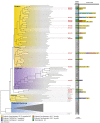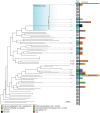Genomic Epidemiology Linking Nonendemic Coccidioidomycosis to Travel
- PMID: 36573555
- PMCID: PMC9796224
- DOI: 10.3201/eid2901.220771
Genomic Epidemiology Linking Nonendemic Coccidioidomycosis to Travel
Abstract
Coccidioidomycosis is a fungal infection endemic to hot, arid regions of the western United States, northern Mexico, and parts of Central and South America. Sporadic cases outside these regions are likely travel-associated; alternatively, an infection could be acquired in as-yet unidentified newly endemic locales. A previous study of cases in nonendemic regions with patient self-reported travel history suggested that infections were acquired during travel to endemic regions. We sequenced 19 Coccidioides isolates from patients with known travel histories from that earlier investigation and performed phylogenetic analysis to identify the locations of potential source populations. Our results show that those isolates were phylogenetically linked to Coccidioides subpopulations naturally occurring in 1 of the reported travel locales, confirming that these cases were likely acquired during travel to endemic regions. Our findings demonstrate that genomic analysis is a useful tool for investigating travel-related coccidioidomycosis.
Keywords: Coccidioides phylogeography; airborne infections; coccidioidomycosis; epidemiology; fungi; genomics; respiratory infections; travel-related illness; whole-genome sequencing.
Figures


References
MeSH terms
LinkOut - more resources
Full Text Sources
Medical

